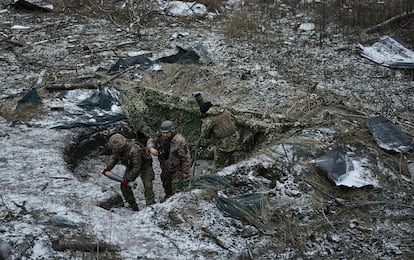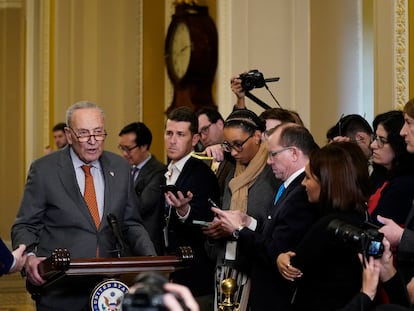With a long war looming, Ukraine stares into the abyss
As Western support for Kyiv has faltered, the counteroffensive has collapsed and citizens are beginning to feel fatigue. The Kremlin has taken the opportunity to float the idea of a pause in fighting


Three days a week, Marina and Artem go to class underground. Their school is a prefabricated cubicle installed in the Kharkiv metro. The choice of location is meant to protect children from Russian attacks, in what was once Ukraine’s second-most populous city.
To the south –—in the recovered city of Kherson — the administration has built armored booths in several streets, to provide some protection against the hail of artillery that the Kremlin launches with relish. It was in Kherson where the Russians suffered their worst defeat of the invasion, in the fall of 2022.
In Ukraine, a whole host of temporary solutions have acquired a certain permanence. Today, Western support appears to be waning… and some doubt whether it will endure. The Ukrainian counteroffensive hasn’t achieved its desired objectives, while Russian forces have embedded themselves, trying to gain ground on the eastern flank. Amidst this reality, Ukraine is looking into the abyss of a long war.
“No one knows when it will end,” admitted Ukrainian President Volodymyr Zelenskiy last Tuesday. “Even experts — our commanders and our Western partners — don’t know this,” the leader remarked, in his annual press conference. Still, he has offered a resounding “no” to the question about whether Ukraine is losing the war. Russian President Vladimir Putin, meanwhile, hasn’t achieved his objectives of destroying Ukraine’s sovereignty. He’s now fighting to take back pieces of combat-ravaged terrain and gain footholds to improve his positions, so that new large-scale attacks can be launched.
Moscow hasn’t abandoned its goals. And several U.S. intelligence reports indicate that the decline in Western support — especially economic, but also diplomatic — could lead to the collapse of Ukraine’s defensive capacity. “The current situation isn’t a stable stagnation… the current unstable balance could tilt in any direction, due to decisions made in the West,” notes the Institute for the Study of War, a Washington-based think tank that closely follows the situation in Ukraine.
Analyst Maria Avdeeva points out that the political turbulence in the United States — namely, infighting between Republicans and Democrats — has frozen some $61 billion in promised aid to the government in Kyiv. Meanwhile, Donald Trump’s return to the White House in the fall of 2024 cannot be ruled out. The populist former president hasn’t only questioned Joe Biden’s foreign policy: he also has a complicated relationship with Ukraine.
Closer, in the European Union (EU) — which has given Kyiv its biggest victory in months, by opening accession negotiations with Ukraine — leaders are looking for a formula to launch an economic lifeline of 50 billion euros ($55 billion) to Kyiv, to be paid out between 2024 and 2027. However, Hungarian Prime Minister Viktor Orbán vetoed this measure a week ago.
“The money will arrive no matter what,” a high-ranking EU source assures EL PAÍS. “There are several creative solutions, such as plan B and even plan C.” Still, the source acknowledges that the delay is hurting Ukrainian efforts to repel Russia.
American funds are more flexible and can be used to pay for military equipment, but the European lifeline is aimed at covering current expenses. This is according to Maria Mezentseva, a Ukrainian legislator who belongs to Zelenskiy’s Servant of the People party. She heads the parliamentary committee for National Affairs. The EU has designed the new financial instrument as a long-term security commitment to keep the country afloat.
Josep Borrell — the vice-president of the European Commission — has tried to unlock new funds for military materials, while pushing for Ukraine to receive the million rounds of artillery that the EU promised Kyiv back in March. This coming June, there will also be elections to the European Parliament, with Ukraine surely marking the political campaign across 27 member states.
Slow progress on the frontlines
With the collapse of the counteroffensive (little ground has been made, with Ukrainian troops only advancing a few feet a day) and the lack of goals in the short and medium-term mean that no advantageous turning point is visible at the moment. “There’s fear of a freeze in the war, but also of new large-scale attacks,” Avdeeva notes. The prospect of joining the EU is also perceived more as a long-term gain, she adds. Ukraine is looking for closer targets.
At the same time, faltering Western support for Ukraine — as well as the fact that the focus is now on supporting the Israeli war on Gaza — has meant that the Kremlin is taking advantage of the situation, announcing that it’s willing to open peace talks to freeze the conflict, now that it controls 20% of Ukrainian territory. Moscow’s troops have suffered heavy losses. A Western intelligence source warns that Putin’s insinuations — also collected by The New York Times via several senior Russian and American officials — are “a way of sowing” possible fatigue both in Ukraine and in the West.
In Dnipro, in the center of the country, a certain normality has established itself. Restaurants and cafés are open and full. A Christmas tree has been installed on one of the large boulevards. At the same time, a large part of the citizenry is exhausted. There’s fatigue, a certain sadness. But there’s no defeatism. Several recent surveys indicate that the population isn’t willing to give up territory to Russia.
“Maybe we quickly forget the much worse moments that we’ve experienced, like last winter,” remarks Serhii Moliasov, with a wool hat in his hand. It’s cold, but at the moment, winter is being more benevolent than in the past. Additionally, this year, air defenses — reinforced with Western aid — have prevented the Kremlin from reaching the energy infrastructure and taking advantage of the cold weather. Last December, many Ukrainians had to spend weeks without light or heating, while getting a generator was difficult. At the end of 2022, the Christmas celebrations in Dnipro and other cities took place in the dark. Not so in 2023.
At the front, many soldiers are beyond exhausted. “It’s like living the same day every day. Over and over again,” Maksim sighs. He fights in an infantry brigade in the mud of the Donbas region. “But withdrawing isn’t an option — it’s an existential question for us here and for our families at home,” he clarifies, while finishing a cigarette in Kostiantynivka, a few miles from Bakhmut, the city that fell into Russian hands at the beginning of summer.
There’s little turnover at the front. There are few new volunteers. Given the lack of recruits, there’s been a draft imposed in certain parts of Ukraine… although the way in which this has been carried out has caused controversy, while there have been cases of bribery to avoid being called up. Zelenskiy has hinted that he may decree a large-scale mobilization. According to the Ukrainian president, the army needs half-a-million new soldiers.
The decision could create anger against the government and the president. His popularity has fallen, while there are certain political rifts, along with an opposition that wants to take him on. The decision about the draft, however, hasn’t been made, Zelenskiy clarifies. A Western intelligence source points out that while the new mobilization measures could indeed be implemented, the number of recruits may be lower than what the president has stated.
Ukraine is now living through different realities. There’s the battle at the front, in the trenches. There’s combat with drones and the exchange of artillery, along with hand-to-hand fighting in places like Avdiivka. Soldiers complain about the lack of fuel in Kherson. And, in the capital — or in other vibrant cities across western Ukraine, or in Odessa, the pearl of the Black Sea — there’s abundance and smuggling.
Oleksandra Bolshakova is a psychologist. She explains that these differing realities — in which some Ukrainians perceive the war as distant, while others deal with it as a matter of physical survival — can directly impact recruitment.
Finding a balance is complicated. Citizens emphasize that the final objective is to recover the territory of Ukraine up to the internationally-recognized borders. That is, with the Crimean Peninsula — illegally annexed by Russia in 2014 — and the occupied territories of the Donbas region. But there are those who demand a closer horizon, with concessions.
The government in Kyiv, meanwhile, has stressed that it won’t put specific objectives on the table again — as it did with the failed spring counteroffensive — since this could harm the fight. “It’s normal, we’re at war, but this uncertainty of not knowing what’s going to happen in a month, a week… it grips your brain,” Moliasov concludes.
Sign up for our weekly newsletter to get more English-language news coverage from EL PAÍS USA Edition
Tu suscripción se está usando en otro dispositivo
¿Quieres añadir otro usuario a tu suscripción?
Si continúas leyendo en este dispositivo, no se podrá leer en el otro.
FlechaTu suscripción se está usando en otro dispositivo y solo puedes acceder a EL PAÍS desde un dispositivo a la vez.
Si quieres compartir tu cuenta, cambia tu suscripción a la modalidad Premium, así podrás añadir otro usuario. Cada uno accederá con su propia cuenta de email, lo que os permitirá personalizar vuestra experiencia en EL PAÍS.
¿Tienes una suscripción de empresa? Accede aquí para contratar más cuentas.
En el caso de no saber quién está usando tu cuenta, te recomendamos cambiar tu contraseña aquí.
Si decides continuar compartiendo tu cuenta, este mensaje se mostrará en tu dispositivo y en el de la otra persona que está usando tu cuenta de forma indefinida, afectando a tu experiencia de lectura. Puedes consultar aquí los términos y condiciones de la suscripción digital.
More information
Archived In
Últimas noticias
New York enters the era of Zohran Mamdani
Welcome to the post-religion era: The idea of Christianity as the absolute truth has become obsolete
‘I thought you would like it’: The risky sexual practice popularized by TV shows and TikTok
The digitalization of tourism: ‘They promise experiences and gave us the worst possible one’
Most viewed
- Sinaloa Cartel war is taking its toll on Los Chapitos
- Reinhard Genzel, Nobel laureate in physics: ‘One-minute videos will never give you the truth’
- Oona Chaplin: ‘I told James Cameron that I was living in a treehouse and starting a permaculture project with a friend’
- Why the price of coffee has skyrocketed: from Brazilian plantations to specialty coffee houses
- Silver prices are going crazy: This is what’s fueling the rally









































